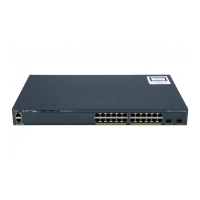12-6
Catalyst 2960 and 2960-S Switches Software Configuration Guide, Release 15.0(1)SE
OL-26520-01
Chapter 12 Configuring Interface Characteristics
Understanding Interface Types
• IEEE 802.3af—The major features of this standard are powered-device discovery, power
administration, disconnect detection, and optional powered-device power classification. For more
information, see the standard.
• IEEE 802.3at —This PoE+ standard supports all the features of 802.1af and increases the maximum
power available on each PoE port from 15.4 W to 30 W. The UPoE feature provides the capability
to source up to 60 W of power (2 x 30 W) over both signal and spare pairs of the RJ-45 Ethernet
cable by using the Layer-2 power negotiation protocols such as CDP or LLDP. An LLDP and CDP
request of 30 W and higher in presence of the 4-wire Power-via-MDI TLV can provide power on the
spare pair.
For more information about UPoE, see Universal Power Over Ethernet, page 12-11.
Note Only Catalyst 2960-S or 2960-C switches support IEEE 802.3at.
Powered-Device Detection and Initial Power Allocation
The switch detects a Cisco pre-standard or an IEEE-compliant powered device when the PoE-capable
port is in the no-shutdown state, PoE is enabled (the default), and the connected device is not being
powered by an AC adaptor.
After device detection, the switch determines the device power requirements based on its type:
• A Cisco prestandard powered device does not provide its power requirement when the switch detects
it, so a switch that does not support PoE+ allocates 15.4 W as the initial allocation for power
budgeting; a PoE+ switch allocates 30 W (PoE+).
The initial power allocation is the maximum amount of power that a powered device requires. The
switch initially allocates this amount of power when it detects and powers the powered device. As
the switch receives CDP messages from the powered device and as the powered device negotiates
power levels with the switch through CDP power-negotiation messages, the initial power allocation
might be adjusted.
• The switch classifies the detected IEEE device within a power consumption class. Based on the
available power in the power budget, the switch determines if a port can be powered. Table 12-1 lists
these levels.
The switch monitors and tracks requests for power and grants power only when it is available. The switch
tracks its power budget (the amount of power available on the switch for PoE). The switch performs
power-accounting calculations when a port is granted or denied power to keep the power budget up to
date.
Table 12-1 IEEE Power Classifications
Class Maximum Power Level Required from the Switch
0 (class status unknown) 15.4 W
14 W
27 W
3 15.4 W
4 30 W PoE+ devices only

